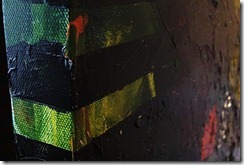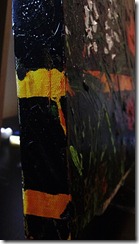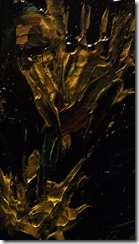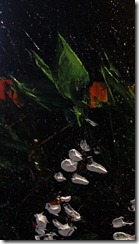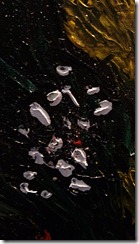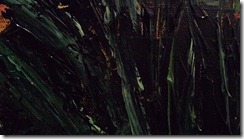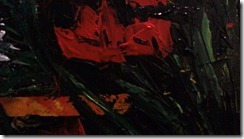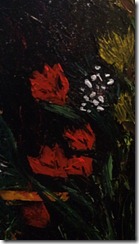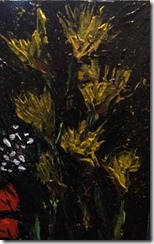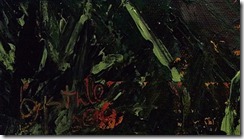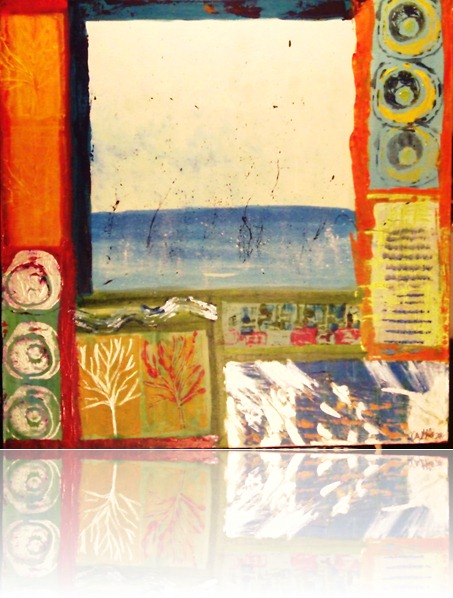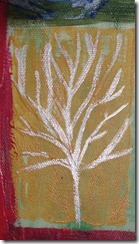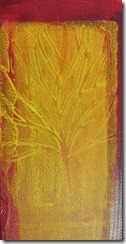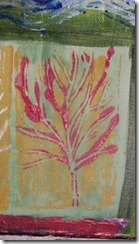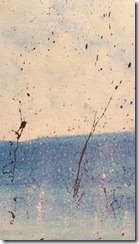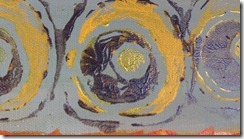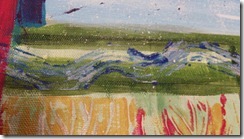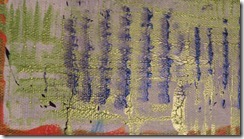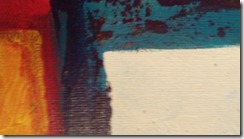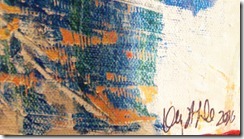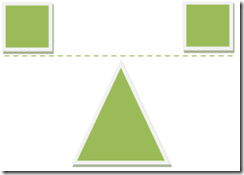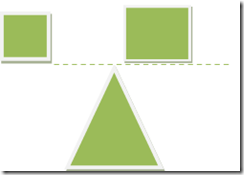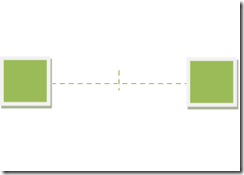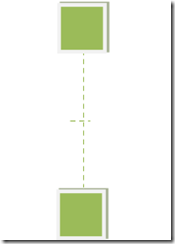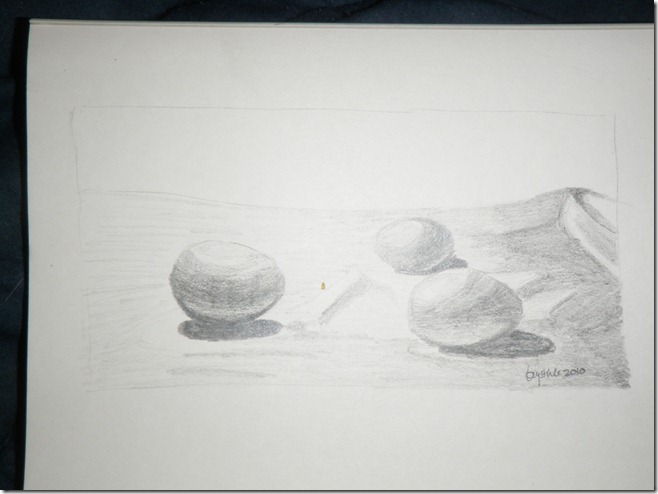Thursday, August 12, 2010
Wednesday, August 11, 2010
Night Flowers
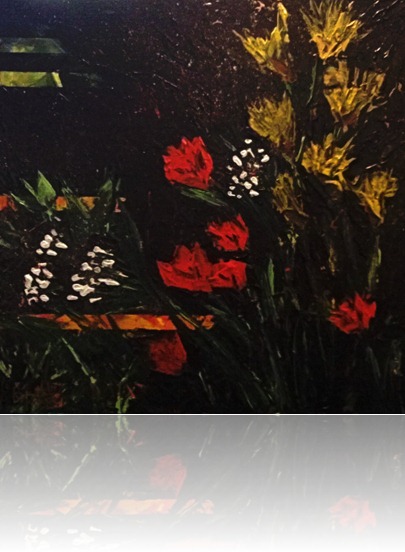
This painting was recently created by me at weekend art workshop. It started out as an abstract painting. The lines of color against the black background are the remains of the abstraction. Suddenly, after putting down some yellow ochre flowers started emerging and I went with the flow.
Here are some close-ups. Click on the images to have a bigger view.
Night Flowers
Tuesday, August 10, 2010
Inner landscapes: A brush with abstraction
This latest painting was created during an intensive creative weekend workshop. The purpose was to create an abstract painting with a few figurative elements, all the while exploring the concept of inner landscapes or inner self with outer landscapes. Trying to create the parallel between both isn’t so easy when you are trying to be abstract.
This work of art is also like a landscape, in the sense that it’s a piece of land and self with a unique point of view, the view of the observer. This inner landscape has many meanings. And if you see something in it, then it’s your own interpretation. Take a minute before reading on and explore it, and try and give it a sense.
The sense it has for me is multidimensional. First, some part of the painting are very busy, just like my mind and my life. All the while other parts seem more tranquil and relaxed.
The trees that you will find are representative of an ever-growing love for arts, for knowledge and awareness.
The focus of interest is a more relaxed, serene scene that may remind some of a body of water. This wasn’t my intention. The colors have a more profound significance. The white is to remind us of innocence and purity, while the blue reflects interior force and peace of mind. You might have noticed those black stains. Indeed they stain the happiness and goodness of life.
Circles have always been very symbolic throughout the history of art. Here they are a reminder of the cycle of life and a reminder to avoid vicious cycles.
A reminder to let thing flow and go.

Energy.
More circles.
These last three pictures don’t have a specific meaning, but are shown as close-ups.
Inner landscapes: A brush with abstraction
Australian Aboriginal Art
Australian Aboriginal Art
I just discovered this artist's blog the other day. She is great at what shes does and brings loads of insights and fascinating comments to her art and to art she has seen. Her post on Australian Aborignal Art is amazing. A must see!

I just discovered this artist's blog the other day. She is great at what shes does and brings loads of insights and fascinating comments to her art and to art she has seen. Her post on Australian Aborignal Art is amazing. A must see!
Australian Aboriginal Art
Monday, August 2, 2010
Principles of design in two-dimensional design
The elements of design is “what” the artist uses to achieve a good design. The principles of design is “how” the artist uses these elements. The principles or design are unity, balance, rhythm, harmony, emphasis and contrast.
Most people find unity pleasing, because it implies order, a sense of organization and structure. To achieve it in your art, you need to select elements of design that belong together.
![MP900316897[1] MP900316897[1]](http://lh3.ggpht.com/_NViowj8c4oc/TFZgXtgGajI/AAAAAAAAAoM/71CG-_jlS08/MP9003168971_thumb1.jpg?imgmax=800)
What gives this picture a feeling of unity? Observe how the light shades of foliages are repeated in the foreground and background. The shade in the foliage in the foreground is repeated to the right of the image on the tree covered mountain. And the water in the foreground reflects the colors of the sky and the mountains in the background. Diagonal shapes are found in the mountains and in the layout of the water and the shrubbery. All of these elements work together to create a sense of unity.
Here are some examples:

Unity
Unity is described as an effect resulting from individual elements of a whole that are in harmony with each other. Moreover, all these elements support the overall design and feel like they belong together. Think of a woman whose makeup, clothing, jewellery, shoes and purse seem like they where made for each other. That’s unity.Most people find unity pleasing, because it implies order, a sense of organization and structure. To achieve it in your art, you need to select elements of design that belong together.
![MP900316897[1] MP900316897[1]](http://lh3.ggpht.com/_NViowj8c4oc/TFZgXtgGajI/AAAAAAAAAoM/71CG-_jlS08/MP9003168971_thumb1.jpg?imgmax=800)
What gives this picture a feeling of unity? Observe how the light shades of foliages are repeated in the foreground and background. The shade in the foliage in the foreground is repeated to the right of the image on the tree covered mountain. And the water in the foreground reflects the colors of the sky and the mountains in the background. Diagonal shapes are found in the mountains and in the layout of the water and the shrubbery. All of these elements work together to create a sense of unity.
Balance
Balance in art is very similar to physical balance. Both imply a state of equilibrium or poise. In art, some combinations of lines, shapes and values are more pleasing are more pleasing than other, because they are balanced. The rules are simple, you want to keep things balanced. In order to achieve balance, you must consider the weight of the elements you have in your composition. The darker a value, the more weight it has. Similarly, the bigger the subject, the more weight it has. If you put to equal size objects at equal distance from the center of a picture, you have balance. If you add some weight to one side, you must compensate for the other. You can either move the the heavier subject closer to the middle or move the lighter object farther from the middle. Also, you can increase size or value to the lighter object so that both are in a state of equilibrium.Here are some examples:
This seesaw is perfectly balanced. The weights on either side have the same shape, the same size, same value and are equal distance from the middle.
This seesaw is also balanced. The bigger object has been moved in closer to the center.
The differences between these two types of balance are called formal and informal. Formal balance exists when forms on opposites sides of the center point match in form, weight, and distance from the center. This type of balance can be horizontal or vertical (see pictures below).
Horizontal formal balance
vertical formal balance
Often times, you’ll find that objects that need to be balanced aren’t the same size and weight. As mentioned above, to get balance in this type of situation, you can increase size of the lighter object or you can change the position of the objects in relation to the center.
These two objects are equal distance from the center, but still in balance because the lighter coloured mass has increased in size. This is called informal balance.
The lighter coloured mass on the left is four times as large as the right mass, but the two are still balanced because the darker mass has been positioned twice as far from the center. This is also an example of informal balance.
Rhythm
Rhythm is created by repetition or progression of visual elements, and moves the viewer’s eye in interesting ways. To achieve this effect, you can create progressions in values (from light to dark), in colors (orange to red), or in sizes (small to large).Harmony
Harmony can be found in the middle of extremes. As an example, in a work of art, contrasts are desirable. But too much will create discord, and not enough will be monotonous.Emphasis
In a work of art, emphasis refers to the center of interest. The center of interest can be a color, a shape, an area, or anything else for that matter. Also, it doesn’t have to be in the middle of the picture plane, it can be located anywhere.Contrast
Contrast refers to putting together more than one elements that has different properties. To achieve contrast, you can use colors or emphasize an elements in the work of art by varying its size, shape, color or texture.Principles of design in two-dimensional design
Sunday, August 1, 2010
Man who sews…Are you loving it?
They say life is a classroom. But who is the real teacher? This guy is! If you are guy, and you keep on saying you can’t sew, you just got schooled.
![MP900177848[1] MP900177848[1]](http://lh6.ggpht.com/_NViowj8c4oc/TFXBkzDl82I/AAAAAAAAAn0/eVDiSEVcEqc/MP900177848%5B1%5D_thumb%5B2%5D.jpg?imgmax=800) Thinking of it, being able to sew a tear or a button should be part of every mans basic skills. Kind of like every guy should be able to figure out the electronics in the home, drive a manual car and a build fire. Reactions?
Thinking of it, being able to sew a tear or a button should be part of every mans basic skills. Kind of like every guy should be able to figure out the electronics in the home, drive a manual car and a build fire. Reactions?

Man who sews…Are you loving it?
Subscribe to:
Posts (Atom)

